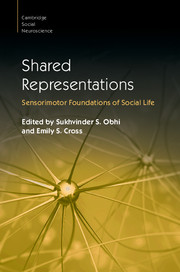Book contents
- Shared Representations
- Cambridge Social Neuroscience
- Shared Representations
- Copyright page
- Contents
- Figures
- Tables
- Boxes
- Contributors
- Preface
- Part I Foundations
- 1 What It Takes to Share a Task
- 2 Merged Minds
- 3 A New View of the Motor Cortex and Its Relation to Social Behavior
- 4 Beyond Action
- 5 Cognizance of the Neuroimaging Methods for Studying the Social Brain
- Part II Imitation and Mimicry
- Part III Thinking, Perceiving and Acting with Others
- Part IV Understanding Others
- Part V Learning and Development
- Part VI Shared Representations in Applied Contexts
- Index
- Plate Section (PDF Only)
- References
1 - What It Takes to Share a Task
Sharing versus Shaping Task Representations
from Part I - Foundations
Published online by Cambridge University Press: 27 October 2016
- Shared Representations
- Cambridge Social Neuroscience
- Shared Representations
- Copyright page
- Contents
- Figures
- Tables
- Boxes
- Contributors
- Preface
- Part I Foundations
- 1 What It Takes to Share a Task
- 2 Merged Minds
- 3 A New View of the Motor Cortex and Its Relation to Social Behavior
- 4 Beyond Action
- 5 Cognizance of the Neuroimaging Methods for Studying the Social Brain
- Part II Imitation and Mimicry
- Part III Thinking, Perceiving and Acting with Others
- Part IV Understanding Others
- Part V Learning and Development
- Part VI Shared Representations in Applied Contexts
- Index
- Plate Section (PDF Only)
- References
Summary
- Type
- Chapter
- Information
- Shared RepresentationsSensorimotor Foundations of Social Life, pp. 3 - 21Publisher: Cambridge University PressPrint publication year: 2016
References
- 9
- Cited by



